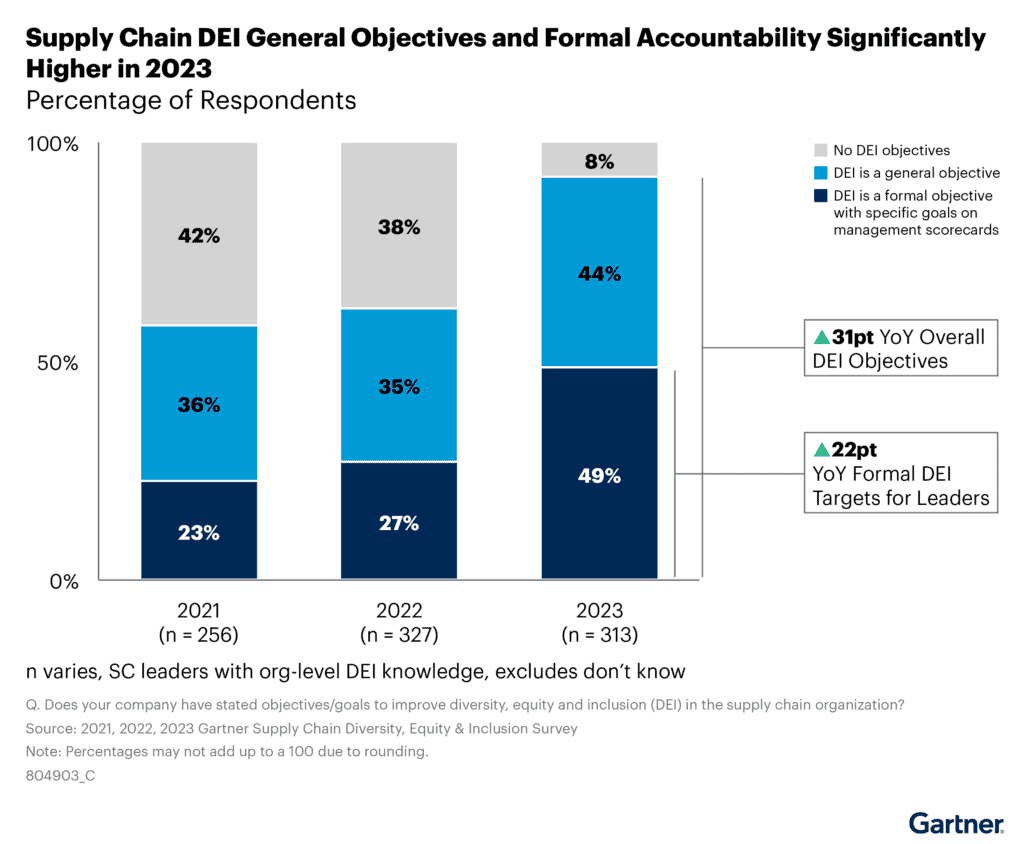A new Gartner survey reveals that up to 49% of supply chain organisations have formal DEI (diversity, equity, and inclusion) objectives with specific targets on management scorecards. The number of supply chain organisations with formal DEI objectives has risen markedly year-over-year, from 27% in 2022 to 49% in 2023 (see Figure 1).
“Supply chain organisations may have been expected to take a step back in pursuing DEI objectives in light of increased scrutiny and economic pressures,” said Dana Stiffler, distinguished VP analyst in Gartner’s Supply Chain Practice.
“Our data instead showed strong gains, with a steep increase in representation of underrepresented races and ethnicities at every level of the supply chain. The key driver of these gains is an increase in accountability via formalised management goals.” Dana Stiffler
Figure 1: Growth in general and formal accountability for DEI, 2021-2023

The survey data revealed major DEI gains, including that the percentage of full-time employees of underrepresented race/ethnicity in the supply chain organisations evaluated increased from 32% to 48%. Compared to 2022’s survey sample, the average representation of talent of underrepresented races and ethnicities is 1.5 times what it was in the 2022 sample.
The data showed a strong alignment between DEI and broader business objectives. Among those who have either formal or general DEI objectives, respondents provided the following reasons for having such goals:
- Attract new talent (68%)
- Engage and retain new employees (64%)
- Improve business performance (58%)
- Attract customers (48%)
- Reflect and support local communities (44%)
- Attract investors (40%)
Stiffler noted that the recruitment focus of DEI initiatives is crucial, with a higher percentage of supply chain employees actively seeking a new job at the highest rate since 2021. “The focus on engagement and retention is also well-placed with supply chain employees less likely than other professions to be highly engaged or have a high intent to stay. Their discretionary effort in mid-2023 was at its lowest point in the past two years,” she added.
“Say-Do Gap” closing; attrition remains high
Beyond formal objectives, a second reason pushing representation higher in 2023 was a greater emphasis on actual DEI initiatives within supply chain organisations. In 2022, while 75% of supply chain organisations reported that they focused on some dimension of diversity, only 40% reported working on specific DEI projects or initiatives. Gartner refers to this gap between intention and tangible action as the “say-do gap.”
“While nearly the same proportion of organisations focused on one or more aspects of DEI in 2023, we saw a much higher percentage of supply chain respondents working on specific DEI projects and initiatives with measurable outcomes, jumping from 40% to 73%,” said Stiffler. “In 2023, the ‘say-do gap’ was reduced to nearly half of what it was in 2021; the connection between tangible action and improved DEI outcomes seems increasingly clear.”
The top four DEI initiatives invested in were learning and development (L&D), benefits, employee engagement and recruitment. In terms of effectiveness, employee engagement and L&D led the list, which is a departure from previous surveys, where inclusive leadership and recruitment were most effective.
While top-line findings in the survey showed progress on diversity efforts, 43% of respondents reported that the attrition rates of underrepresented talent were somewhat or significantly higher compared to their majority workforce. The data suggests talent pipelines need to be assessed and strengthened further to maintain recent gains.
Chief supply chain officers (CSCOs) seeking to reduce attrition must evaluate several potential root causes, including the desire among these employees to seek career changes, the most highly cited reason underrepresented talent left their roles in 2023.



